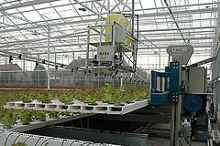Automation Domination: Robotic Hydroponic Lettuce Farm in Belgium

Share
The steady march of industrial automation continues to envelop the world. Many of us have a quaint early 20th century vision of agriculture, but the truth is that the farmer of the 21st century is a machine. Case in point: lettuce. With new hydroponic techniques, companies are able to grow lettuce in large indoor fields where crops are sorted, planted, and grown automatically. Robots are instrumental to all steps of the process. Don't believe me? Check out the video below. It shows the day to day automation for a hydroponic farm in Belgium. Those bots seem to have a pretty green thumb.
Don't worry about the sound, and feel free to skip around a bit. This video is cool, but automated farms aren't exactly the most high speed endeavors in the world. [Insert joke about robots watching the grass grow.]
While I'm unsure of the exact location of the farm, I can tell that the robotics systems used are from Hortiplan, a horticultural automation company based out of the Netherlands. The hydroponic rows you see being filled and maneuvered are part of their Mobile Gully System. The MGS not only plants the lettuce and arranges it in the field, it also moves the crop along as it develops, and delivers it to the right part of the greenhouse for harvest. That picking is done by hand. You can see some (mediocre) clips of the process on the Hortiplan YouTube channel.
Be Part of the Future
Sign up to receive top stories about groundbreaking technologies and visionary thinkers from SingularityHub.


Hydroponics and automation seem to go together very well. Hortiplan's MGS uses what's known as the nutrient film technique. Essentially, the gullies (trays) have a very thin layer of nutrient rich water flowing through them. That water is pumped to one end of the field and then flows downhill (there's a very slight slope on the trays). Lettuce is continually watered, slowly moved across the field by the MGS, which also increases the spaces between gullies so the plants have room to grow. By the time they reach the far end they're ready for harvest.
The nutrient film technique, and various levels of automated lettuce production, have been around for years, but they haven't really reached the public consciousness. So few of us stop to think about where our food really comes from. Industrial agriculture is just another soldier in the automated legion that is changing the way we produce practically everything. As it continues to march on, we'll see more crops like the Belgium lettuce that can be grown with less labor and less resources. Hopefully they will be leveraged to create more food and less hunger all over the world. Awesome! When was the last time you were this excited by lettuce?
Actually, don't answer that, I'm not sure I want to know.
[image credit: Hortiplan]
[video credit: filipmeeuws]
[source: Hortiplan]
Related Articles

These Robots Are the Size of Single Cells and Cost Just a Penny Apiece

In Wild Experiment, Surgeon Uses Robot to Remove Blood Clot in Brain 4,000 Miles Away

A Squishy New Robotic ‘Eye’ Automatically Focuses Like Our Own
What we’re reading
